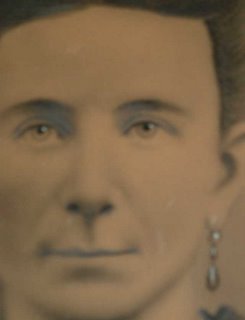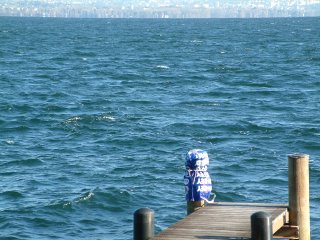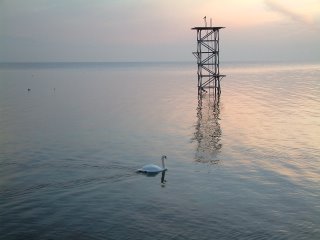Moonbeam drawer, Winding up the wind
For Florence Lonergan Wallace in Kansas City, whose 94th birthday is Thursday.
Her grandmother, Mary Ann Murphy McAvoy, and one thread of daughters: She had a daughter named Anna, who had a daughter she called Florence, and she had a daughter named Ellen, and my daughter is named Tara, after the hill of peace in Ireland.
The wind blows across Switzerland
We left the mountains this morning, very early, and drove down to the Rhone Valley. The Alps were still and starry. The car bumped and rocked, but only the driver noticed that it was the wind that did this.
In Saint-Prex the wind woke us up rudely, pushing at the car doors when we wanted to open them and tugging when we tried to close them. Collars were pulled tight and eyes squeezed shut and we had to shout over the roar of the wind whipping across Lake Geneva and shaking the tall trees around the old Manoir that stands at the tip of our village, a beacon to sailors in summer.
Science on wind
When Liam was four he asked where the wind came from and when he was six he asked why it gusts and dies down. We read answers out of a book. I tried to remember all day what those answers were and I found them again this evening in an odd place, a news channel's web site post in Seattle, from 2003.
History on wind
The where and the why of windiness never change, but that's only half their story. The rest is in our Wind drawer, near the Moonbeam drawer. There's a bit of white sand down there from the Gobi desert, cold sand now that it's winter, but the sand was warm the day a few grains trickled in there, the day the wind was wound up.
The tale from the Wind drawer
A very long time ago, when people began to invent things to make their lives easier, there was a lonely, miserly man who lived in Mongolia, at the edge of the Gobi desert. Few people lived there because there was little food and less water. When he was a young man he found a small place with a water hole that never dried up. He watched and held out his hand to feel the air as the wind moved across the water, rippling it. He thought and thought and one day he invented a way to capture the wind, to harness her to what he called a windmill.
The wind wanted to be free. She didn't like being invisible and not being her own master. Worse, she knew she could be stronger, and she wanted to test that. One day she blew so hard that she blew down the windmill! First happy ending: The miller cried, but fortunately a good woman happened to be walking across the Gobi desert and she decided to keep him company, so the two of them grew old together and the miller, who had learned his lesson, never tried to harness her.
 Second happy ending: Meanwhile, the wind learned that when she skipped over the land she picked up speed and more power. Better yet, she learned that the sun could give her speed, too, and water added to the fun.
Second happy ending: Meanwhile, the wind learned that when she skipped over the land she picked up speed and more power. Better yet, she learned that the sun could give her speed, too, and water added to the fun.
She sang as she headed across the forests of Siberia, skipping over Lake Irkutsk. One day she came to the wide plains of Russia, and the grains of Gobi sand she carried with her warmed in the summer sun. She felt sleepy and learned that the flat stretches slowed her down. Some days she just drifted along.
By the time she came to a place that was later called Berlin she had learned to move and leap and fly and run and twirl. She could sing and whistle and Berlin was the better for it. The wind by now knew she could never be completely tamed again.
 And yet, journeying across the Earth, she began to tire of the endless motion and seamless voyage. One day she discovered the secret of making small breezes, and for some time that gave her great pleasure.
And yet, journeying across the Earth, she began to tire of the endless motion and seamless voyage. One day she discovered the secret of making small breezes, and for some time that gave her great pleasure.
 Soon she had four of them: her daughters. They picked up the thread of the wind and carried it further. By the time they had drawn loops around the globe they learned new secrets. In Russia they saw how to carry snow so they were no longer invisible, and in Lapland how to tease autumn trees into brighter colors so they could dress up and party all night. In Ireland they whirled around the hill called Tara, where the four kings who fought all year came together one day every year to make peace. It was in Ireland that the winds discovered the secret of burning peat so the ancient boglands could begin to turn up their hidden treasures, such as the Tara brooch.
Soon she had four of them: her daughters. They picked up the thread of the wind and carried it further. By the time they had drawn loops around the globe they learned new secrets. In Russia they saw how to carry snow so they were no longer invisible, and in Lapland how to tease autumn trees into brighter colors so they could dress up and party all night. In Ireland they whirled around the hill called Tara, where the four kings who fought all year came together one day every year to make peace. It was in Ireland that the winds discovered the secret of burning peat so the ancient boglands could begin to turn up their hidden treasures, such as the Tara brooch.
They eventually tired of their wild ways and settled down, but they and the Earth and Sun, as well as lakes and mountains and rivers, had learned to love each other, to tug and tease and pull at each other. They knew that to wind up the wind they had to live in harmony
To this day, the four winds that come from north, south, east and west twirl around the world and some days they blow strong and hard, and some days barely at all. They do it to show us that bumping along quietly together one minute can create great, glorious gusts of life another. And that is a beautiful thing when it happens.



0 Comments:
Post a Comment
<< Home